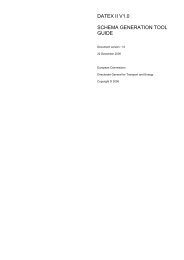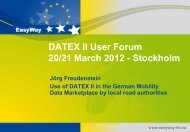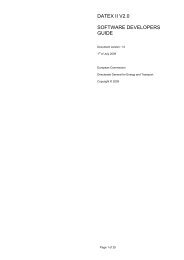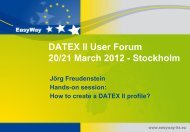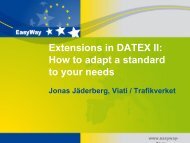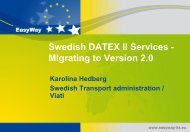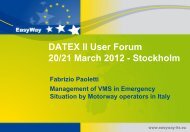Datex II Exchange Specification
Datex II Exchange Specification
Datex II Exchange Specification
Create successful ePaper yourself
Turn your PDF publications into a flip-book with our unique Google optimized e-Paper software.
DATEX <strong>II</strong> <strong>Exchange</strong><strong>Specification</strong>Ricardo FernandesArmisDATEX <strong>II</strong> User Forum20/21 March 2012 – Stockholmwww.easyway-its.eu
Agenda• The challenge ahead of us• Methodology• The work so far• What’s next?DATEX <strong>II</strong> User Forum - Stockholm - 20/21 March 20122
The challenge ahead of us – The Facts• DATEX <strong>II</strong> provides a good and comprehensive data model forthe exchange of traffic and travel information• D2LogicalModel• There are several implementations of the DATEX / DATEX <strong>II</strong>specifications in-place throughout Europe• France• Germany• Italy• Netherlands• Portugal• Spain• Sweden• …just to name a fewDATEX <strong>II</strong> User Forum - Stockholm - 20/21 March 20123
The challenge ahead of us – <strong>Exchange</strong>• Using the same domain model does not necessarilymean two entities can, in fact, communicate.• Several factors must be taken into account:• What technical platform to use?• What information is available for exchange?• How to set up the communication process?• What conditions may “trigger” the data flow?• How to control the communication link?• How can the information lifecycle be communicated?• How to deal with large data sets?• How to recover from failures?• All of these must be part of… DATEX <strong>II</strong> <strong>Exchange</strong>!DATEX <strong>II</strong> User Forum - Stockholm - 20/21 March 20124
The challenge ahead of us – <strong>Exchange</strong> Problems• Although <strong>Exchange</strong> has been part of the DATEXspecification since DATEX I:• The <strong>Exchange</strong> part did not evolve at the same pace the DomainModel has Out-dated• <strong>Exchange</strong> PIM, <strong>Exchange</strong> PSM and <strong>Exchange</strong> Service Descriptors(WSDL) are not aligned Lack of a consistent specification• Does not address all business (and technical) needs Implementers often have to come up with specific solutionsDATEX <strong>II</strong> User Forum - Stockholm - 20/21 March 20125
The challenge ahead of us – The Goal• To revise the <strong>Exchange</strong> <strong>Specification</strong> according to the followingprinciples• Interoperabilityallow different DATEX <strong>II</strong> implementations to successfully engage into a data exchangeprocess.• Support legacy DATEX <strong>II</strong> implementations and based on the previousspecificationin order to maximize investments already made by stakeholders that have DATEX <strong>II</strong>based systems in place.• Address other user profiles and not only road operators and thus make DATEX <strong>II</strong> available to a broader audience.• Reuse of existing standardsin order to reduce implementation complexity and take benefit of proven and alreadyexistent solutions for common IT problems.• Clear separation between the payload content and the exchange modelDATEX <strong>II</strong> User Forum - Stockholm - 20/21 March 20126
Methodology – Model Driven Architecture• Apply the same approach used when elaborating theDATEX <strong>II</strong> content specification• MDA Approach (top-down)!• First the abstract principles of <strong>Exchange</strong> need to be specified Platform independent• Then concrete mappings to particular technologies are provided Depends on the platformDATEX <strong>II</strong> User Forum - Stockholm - 20/21 March 20127
Methodology – Abstract Principles• Step 1 - Identify Business Scenarios• Data Delivery Deals with the exchange of traffic and travel information between twoDATEX <strong>II</strong> nodes, as happens in the regular “Centre-to-Centre” scenario.• Transaction To allow a DATEX <strong>II</strong> node to act directly on another DATEX <strong>II</strong> node byexplicitly requesting the execution of a service.• Step 2 – List all possible <strong>Exchange</strong> features• There might be features that are not suitable for differentexchange scenarios• Some of the features may even collide with each otherDATEX <strong>II</strong> User Forum - Stockholm - 20/21 March 20128
Methodology – Abstract Principles• Step 3 – Define possible DATEX <strong>II</strong> use cases for eachBusiness Scenario and select the appropriate set offeatures used to implement each one• The selection of features for each use case form a FEP –Functional <strong>Exchange</strong> Profile• During this phase we plan to address 3 different use cases for theData Delivery business scenario Simple Push <strong>Exchange</strong> – addresses current Push implementations Simple Pull <strong>Exchange</strong> – addresses current Pull implementations Full Publish/Subscribe <strong>Exchange</strong> – the “Nirvana” DATEX <strong>II</strong> User Forum - Stockholm - 20/21 March 20129
Methodology – Abstract Principles• Step 4 – Produce the Platform Independent Model for<strong>Exchange</strong> – <strong>Exchange</strong> PIM• The FEPs are modelled in a platform independent way As happened with the DATEX <strong>II</strong> domain model UML as modelling tool• Features may be mandatory or optional Each FEP should include such informationDATEX <strong>II</strong> User Forum - Stockholm - 20/21 March 201210
Methodology – Concrete Implementation• The Goal• A real world DATEX <strong>II</strong> <strong>Exchange</strong> implementation in a giventechnical environment• How?• Select a FEP suitable for the application scenario• Select the target implementation platform• This forms an Interoperability Domain!• Interoperability is only ensured for the same FEP-to-technologymapping• …and is specified into a Platform Specific Model – PSMdocumentDATEX <strong>II</strong> User Forum - Stockholm - 20/21 March 201211
Methodology – The outcome• A <strong>Specification</strong> for DATEX <strong>II</strong> <strong>Exchange</strong>• The foundations of a “framework” that will let us easilyextend the <strong>Exchange</strong> <strong>Specification</strong> depending on futureneeds• New FEPs• New platforms• New Interoperability Domains FEP + platformsDATEX <strong>II</strong> User Forum - Stockholm - 20/21 March 201212
The work so far – The documents• A few documents have already been drafted• “DATEX <strong>II</strong> <strong>Exchange</strong> Context and Framework” Details the methodology followed and provides guidance for understandingthe other documents that will make part of the <strong>Specification</strong>• “DATEX <strong>II</strong> <strong>Exchange</strong> Use Cases” Introduces the Business Scenarios addressed by the <strong>Specification</strong>• Other documents we plan to have• Platform Independent Model document(s) - PIM• Platform Specific Model document(s) - PSM• The final arrangement of the whole set of documents isyet to be definedDATEX <strong>II</strong> User Forum - Stockholm - 20/21 March 201213
The work so far – Modelling phase• Depth-first approach• To target one FEP and one platform and produce the end-to-endspecification for that PIM modelling (currently) PSM (next step)• FEP• Full Publish/Subscribe <strong>Exchange</strong>• Platform• Web ServicesDATEX <strong>II</strong> User Forum - Stockholm - 20/21 March 201214
The work so far - PIM• Context Diagram• Definition of the layers that are relevant for <strong>Exchange</strong>• Identification of functions that should be addressed by the<strong>Specification</strong>• How do the functions fit into the different layersDATEX <strong>II</strong> User Forum - Stockholm - 20/21 March 201215
The work so far - PIM• Publish/Subscribe architecture exampleanalysis DATEX<strong>II</strong> SystemDATEX <strong>II</strong> SystemSupplierClientSubscriptionManagermanage subscriptionsSubscribersubscriptiondata«flow»PublisherPayloadPublication«flow»ProducerD2Message«flow»Consumerdata«flow»Supplier System(fromSystemOverview)Client System(fromSystemOverview)DATEX <strong>II</strong> User Forum - Stockholm - 20/21 March 201216
What’s next• We are delivering but at a slow pace• Achieve consensus is a difficult task!• The <strong>Exchange</strong> model is very complex and requires more effortthen we anticipated• It is difficult to say anything about timing at this stage• We hope to have a better insight on the effort behind this after thefirst PIM-to-PSM round is done• We are close to deliver the first PIM draft (during 2Q of2012)• We will then start working on the first PSM draftDATEX <strong>II</strong> User Forum - Stockholm - 20/21 March 201217
QA• Thank you!DATEX <strong>II</strong> User Forum - Stockholm - 20/21 March 201218



